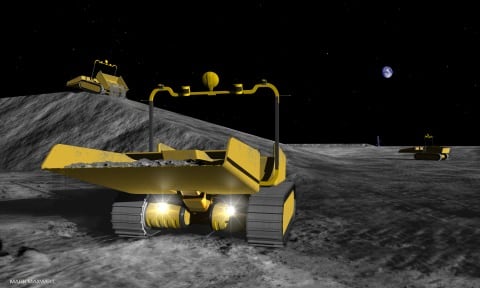[/caption]
A new type of lunar robots is being designed which could help prepare locations on the Moon for human outposts and landing pads. With supervised autonomy, small robots the size of riding mowers and weighing 300 kg or less could prepare a site in about 6 months, says a new study by Astrobotic Technology Inc. in cooperation with Carnegie Mellon University's Robotics Institute.
Anyone else having visions of Wall-E on the Moon?
Using small robots would offer an alternative to bringing large loaders to the Moon, as Caterpillar, Inc. has proposed, and is working on details with NASA of using a big skid steer loader on the Moon (see previous UT article, "
Heavy Construction on the Moon
.")
"NASA faces a challenge in planning the layout for its outpost, which is expected to begin operations in 2020," said William "Red" Whittaker, chairman and chief technical officer of Astrobotic and a Carnegie Mellon professor of robotics. "For efficient cargo transfer, the landing site needs to be close to the outpost's crew quarters and laboratories. Each rocket landing and takeoff, however, will accelerate lunar grit outwards from the pad. With no atmosphere to slow it down, the dry soil would sandblast the outpost."
The research examined two potential solutions: 1) construction of a berm around the landing site, and 2) creation of a hard-surface landing pad using indigenous materials.
In the first solution, researchers found that two rovers weighing 330 pounds each would take less than six months to build a berm around a landing site to block the sandblasting effect. A berm 8.5 feet tall in a 160-foot semi-circle would require moving 2.6 million pounds of lunar dirt. Robots this size can be sent to NASA's planned polar outpost site in advance of human expeditions. Astrobotic Technology Inc. has proposed that landing site preparation be provided by commercial ventures.
In the second solution, researchers showed how small robots could comb the lunar soil for rocks, gathering them to pave a durable grit-free landing pad, said John Kohut, Astrobotic's chief executive officer. "This might reduce the need to build protective berms. To discern the best approach, early robotic scouting missions need to gather on-site information about the soil's cohesion levels and whether rocks and gravel of the right size can be found at the site." [caption id="attachment_26250" align="aligncenter" width="200" caption="Astrobotic's plan for lunar rover for Google Lunar X-PRIZE. Credit: Astrobotic Tech"]
[/caption] Whittaker is directing the development of Astrobotic's first lunar robot, which is vying to win the $20 million Google Lunar X-PRIZE by visiting the Apollo 11 landing site and transmitting high-definition video to Earth. They are looking to launch in December 2010. The robot has been undergoing field trials for several months.
Details of the study are available at www.astrobotictech.com.
 Universe Today
Universe Today
